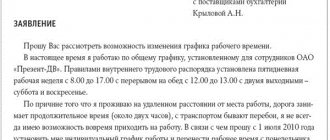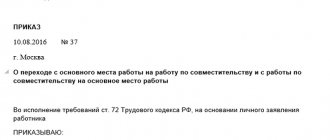The workplace description is not an official document, but it is quite often in demand in personnel records management. It may be required for an employee to register a disability or when drawing up a workplace design. In different situations, a document may have its own drafting features. However, there is no approved form of such a document and companies can independently develop it and approve it in their local regulatory documents. In the article we will look at why a workplace profile is needed, how to compile it, and also provide a sample of it.
What is a workplace characteristic?
The characteristics of the workplace is a document that is drawn up according to the conditions of production activities. Such a document may be required if it is necessary for an employee to undergo a medical examination to establish a disability, in the case of students undergoing certification, or when improving the qualifications of employees . Despite the fact that such a concept as “workplace characteristics” is not used in regulatory legal acts, it can be found quite often in regional or industry-specific regulatory documents.
Bottom line
A characterization is a story about an employee that is not limited by strict boundaries. The volume of the document depends on the person’s achievements in the work field and on the manager’s desire to list the employee’s achievements and qualities. Despite the lack of a strict document template, managers still write it, adhering to certain standards.
It is useful to know what a gray salary is and the employer’s responsibility for such payments, as well as how to write an explanatory note correctly?
When is a workplace characteristic needed?
If an employee requires an expert assessment to determine the degree of disability or to determine incapacity, as well as to establish disability, then a certificate describing his workplace may be required. In addition, this document may also be needed when certifying an employee, or in the case of personnel selection. Also, characterization of working conditions can be useful in internal office work. In this case, the document contains information about the employees’ personal workplaces, as well as about the collective workplace. The certificate describes the workplace in some detail, as well as its location and equipment (
Equipment and layout of workplaces.
The equipment and layout of workplaces is the basis of their organization. Elements of equipment for workplaces are main and auxiliary equipment, organizational and technological equipment.
The main equipment includes machines, machines, mechanisms, etc.
Auxiliary equipment consists of lifting devices, various conveyors, control instruments, test benches and other auxiliary equipment.
Technological equipment includes tools (cutting, measuring, auxiliary tools, dies, fixtures, etc.) and technical documentation.
The main technological and auxiliary equipment, as well as technological equipment, must correspond to the technological or production process. They are provided for in the design of the enterprise (workshop, site) and technological maps.
The standards for the required technological equipment are determined by the current technology for manufacturing the product. In this case, standard and unified technological equipment (universal prefabricated devices, etc.) is used to the maximum, which significantly speeds up and reduces the cost of its production.
Organizational equipment includes:
— devices for placing and storing technological equipment, workpieces, raw materials, materials, finished products, and waste at workplaces;
— industrial furniture;
— signaling and communication equipment, local lighting;
— equipment and workplace care items (brushes, oilers, hooks, etc.);
— fencing and safety devices;
— details of the industrial interior.
The factors influencing the choice of the necessary organizational equipment are in many cases less certain than the factors determining the choice of technological equipment. The list of organizational equipment, its quantity, and design characteristics depend on the specifics of the technology, objects and means of labor, the features of the established workplace maintenance system, as well as on sanitary and ergonomic factors and other production conditions,
Due to the complexity of establishing a list of necessary organizational equipment for workplaces, subjective decisions cannot be ruled out, leading to either a lack or excess of equipment. The lack of organizational equipment in the workplace, the imperfection of its designs cause unnecessary or irrational movements of the worker, lead to direct loss of time, underutilization of equipment and, ultimately, to a decrease in labor productivity. At the same time, excess equipment clutters workplaces, complicates the transportation of objects and means of labor, and causes unproductive financial and labor costs.
Workplace designs usually provide facilities for storing and placing fixtures, tools, workpieces, semi-finished products, finished products, industrial furniture, equipment care products, fencing and safety devices, etc. However, many workplace equipment projects do not have recommendations on communication and alarms, various equipment downtime recorders, production accounting, as well as small-scale mechanization equipment and auxiliary hand tools.
When choosing organizational equipment for the workplace, more attention should be paid to auxiliary devices and devices that form the basis for the mechanization of auxiliary work.
The simplest way to establish a list of necessary organizational equipment and the rationality of its design is to compare the actual availability of equipment with a standard project developed for a given workplace, or a labor organization map. In their absence, it is advisable to analyze the organizational equipment of the workplace.
Organizational equipment includes a large range of products, which requires a special approach to its design. Ergonomic requirements for the design of organizational equipment and equipment are basically identical, but there are also specific requirements for individual groups and types of organizational equipment.
For example, when designing tables, workbenches and other types of organizational equipment in accordance with ergonomic requirements, it is necessary to ensure the optimal height of the working surfaces, rational space for the legs, correspondence of the height of the working surfaces to the level of the arms of a sitting person bent at the elbow joints, the optimal dimensions of the working surface depending on the size and the number of products, tools, instruments, control devices, taking into account reach zones.
The design of organizational equipment and industrial furniture must ensure the correct working posture (the forward tilt angle of the body is no more than 15° with a slight bend in the lumbar spine) and the ability to change the position of the worker’s body. The height of the working surfaces of organizational equipment and the seat must correspond to the anthropometric data of the employee.
When designing racks and cabinets, it is important to consider: their optimal height dimensions depending on the method of service (manually without stands and stepladders, with their help, and also with the help of stackers); the width of the racks depending on the dimensions of containers and products, ease of installation and removal; ease of finding the necessary products, containers and the ability to record stored products.
When designing organizational equipment, attention should also be paid to compliance with sanitary and hygienic requirements: installation of suction systems for work that releases toxic gases or dust; covering seats, backs and armrests with materials of low thermal conductivity; ensuring ease and noiselessness of movement of individual elements (drawers, shelves, backs and seats of chairs, etc.); production of table tops, workbenches made of wood finished with synthetic and other materials, depending on the nature of the work performed.
An ergonomic requirement is to ensure the aesthetic perception of the designed organizational equipment. First of all, it must have a rational color design in accordance with its functional purpose, psychophysiological effect and production conditions. Painting is carried out taking into account the nature of illumination, the level of production noise, climatic conditions, the number of workers, their composition by gender and age and a number of other factors.
How is the workplace described?
The workplace description is free-form, but when drawing it up, you should follow the rules of personnel records management . The certificate is issued on company letterhead and contains the following:
| Details of the characteristics from the place of work | What is indicated |
| Employer information | The organizational and legal form of the company, its name and registration address. The actual address of the company may also be indicated. |
| Employee information | Passport details, employee position, work experience |
| Information about the nature of the work | Information is provided that reflects the load on the employee’s musculoskeletal system, as well as its other functional systems. |
| Work time | Duration of the working day, including the number and time of breaks |
| Hygienic features of work | Degree and level of pollution, noise, temperature conditions |
| Performance | For example, in quantitative terms (number of products per unit of time), or employee performance |
| Measures to reduce the level of harmful working conditions, as well as to make work easier | It is indicated, for example: · elimination of exposure to harmful factors; · reduction of mechanical noise, vibrations, radiation; · introduction of means of protection against negative impacts. |
If the characteristics are drawn up to search for and accept an applicant, then it indicates the general characteristics of the premises and workplace. The following is indicated:
- workplace area;
- illumination, noise level;
- type of equipment;
- equipment provided by the employer for work.
Important! The certificate is signed by the persons who compiled and executed this document. And the finished specification is approved by the head of the company. The document is certified by the signature and seal of the organization (if any).
Document requirements
The characteristics are drawn up in free form; there are no universal forms. The main requirement for a document is the ability to unmistakably identify who it is about. Therefore, it is appropriate to include in the description not only the name, but also the employee’s passport details with registration address.
To achieve the most understandable presentation, adhere to the following structure:
- name of the organization and date of compilation;
- personal data of the employee - full name, date of birth, passport details, education, marital status (optional):
- job title;
- experience;
- main responsibilities, functions;
- level of qualifications, professional characteristics;
- achievements in the workplace;
- additional education, advanced training during work in the organization;
- personal characteristics influencing professional activity;
- comments, shortcomings, claims from management (optional, only in negative characteristics);
- purpose of compilation;
- signature of the originator (manager, immediate superior or HR department employee).

The characteristics are drawn up according to the requirements of the employee, at the request of the employer or for government agencies
In what cases may it be necessary
There are several reasons why characterization may be required:
- to bring to disciplinary liability at work;
- if the employee is nominated for an elective position;
- at the request of state or municipal authorities;
- at the request of the employee, for presentation at the new place of work.
The purposes for drawing up the document do not affect its content: the employer will reflect the same data there. That is, the specification at the place of request at the request of the employee will be similar to the document at the request of the government agency.
Characteristics of the workplace for registration of disability: sample
In order for a citizen to register a disability, he needs to contact the territorial bureau of medical and social examination with an application. At the same time, he will need to collect a certain list of documents, which will also include characteristics of the workplace. The characteristics, among other documents, are of particular importance, as they allow us to determine the applicant’s ability to work. This document is issued by the employer; it looks like a certificate. The certificate can be drawn up by the HR department and signed by the manager. A document is filled out specifically for medical and social examination. The form of this document is not approved by law, so it can be drawn up in any form. When drawing up a certificate, you should indicate the following: features of the work, work schedule, degree of severity, level of harmfulness of working conditions.
Important! If a certificate is required to register a disability, it indicates the employee’s passport details, his education and qualifications.
The characteristics indicate the personal characteristics of the employee, as well as general information about the employer. If the employee received injuries while performing work, these are also indicated in the certificate. In addition, the possibility of transferring the employee to another job, additional information, the state of health of the employee, as well as the scope of his previous activity may also be indicated. A certificate is drawn up in the presence of the following services:
- medical;
- health center;
- expert commission;
- company administration.
Important! In the certificate for the ITU, it is important to indicate the nature of the employee’s work, his work schedule, as well as the severity of the work performed and the harmfulness of the working conditions.
Sample characteristics
How to fill out a production characteristic for the ITU
PRODUCTION CHARACTERISTICS1. Last name, first name, patronymic of the citizen sent for medical and social examination (hereinafter referred to as citizen):
____________________________________________________________________________________________
2.Name and address of the organization in which the citizen works:
____________________________________________________________________________________________
____________________________________________________________________________________________
3. Workshop, department
____________________________________________________________________________________________
4.Form of labor organization (individual, conveyor, team, at home, etc., please indicate): b
____________________________________________________________________________________________
5. Who does he work at the time of referral for medical and social examination:
____________________________________________________________________________________________
(indicate position, profession, specialty, qualifications and work experience for the specified position, profession,
specialties, qualifications; for non-working citizens, make an entry: “not working”)
6. Main profession (specialty):
____________________________________________________________________________________________
7.Qualification in the main profession (class, rank, category, title):
____________________________________________________________________________________________
8. Related professions and specialties:
____________________________________________________________________________________________
9. Factors of working conditions:
9.1. Working hours (working hours, breaks, shifts, pace of work):
____________________________________________________________________________________________
9.2. Working conditions (work in the workshop, on the street, occupational hazards, microclimate conditions, describe in detail):
____________________________________________________________________________________________
____________________________________________________________________________________________
____________________________________________________________________________________________
____________________________________________________________________________________________
9.3. Workplace (stationary, non-stationary, specify others):
____________________________________________________________________________________________
9.4. Working posture (free, fixed, mainly standing, sitting, variable, specify):
____________________________________________________________________________________________
9.5. Category of severity of work performed:
____________________________________________________________________________________________
9.6. Physical severity of labor (maximum weight of cargo lifted and moved manually; total weight of loads during the hour of each hour of shift, from the working surface, from the floor; body tilts; movement in space):
____________________________________________________________________________________________
____________________________________________________________________________________________
____________________________________________________________________________________________
____________________________________________________________________________________________
10. Labor intensity:
10.1. Emotional load (degree of responsibility, significance of the error, degree of risk for the safety of other persons, others, please indicate):
____________________________________________________________________________________________
____________________________________________________________________________________________
10.2. Intellectual load (content of work, degree of difficulty of tasks):
____________________________________________________________________________________________
____________________________________________________________________________________________
____________________________________________________________________________________________
____________________________________________________________________________________________
10.3. Sensory load (duration of concentrated observation (as a percentage of shift time, load on the visual and auditory analyzer, monotony of the load):
____________________________________________________________________________________________
____________________________________________________________________________________________
____________________________________________________________________________________________
____________________________________________________________________________________________
11. Brief description of the work performed (main production operations):
____________________________________________________________________________________________
____________________________________________________________________________________________
____________________________________________________________________________________________
____________________________________________________________________________________________
12. Does he enjoy easier working conditions (shorter working day or week, is the volume of work reduced, breaks in work, special devices, if not, can they be provided, indicate which ones):
____________________________________________________________________________________________
____________________________________________________________________________________________
____________________________________________________________________________________________
____________________________________________________________________________________________
13. Is it possible to transfer to another job (what kind; the possibility of retraining, retraining):
____________________________________________________________________________________________
____________________________________________________________________________________________
____________________________________________________________________________________________
14.Labor productivity (copes, fails, fulfills the norm, does not fulfill):
____________________________________________________________________________________________
15. Remuneration system (rate, piecework, hourly, progressive bonus):
____________________________________________________________________________________________
16. Earnings for the last 12 months for each individually:
October 2021 – 20,000 rub.
November 2021 – 20,000 rub.
December 2021 – 20,000 rub.
| January 2021 – 20,000 rub. February 2020 – 20,000 rub. March 2021 – 20,000 rub. | April 2020 – 20,000 rub. May 2021 – 20,000 rub. June 2021 – 20,000 rub. | July 2021 – 19,000 rub. August 2021 – 19,000 rub. September – 19,000 rub. |
17. Number and duration of cases of temporary disability over the last 12 months:
____________________________________________________________________________________________
| ( job title) | (signature) | (transcript) |
| ( job title) | (signature) | (transcript) |
What does a workplace characteristic give to an employer?
Based on the compiled characteristics of the workplace, the employer can analyze the working conditions of its employees and create better conditions for:
- placement of the employee based on his movement and movements during work, as well as according to the requirements of the technological process;
- performing work operations in a comfortable position, in accordance with the specifics of the work, as well as using effective work techniques;
- location of controls within optimal conditions and room boundaries;
- creating optimal sources for obtaining visual information without changing working position;
- free access to facilities and places for repair and adjustment of equipment;
- rational placement of working equipment, ensuring the safety of its use.
Compilation rules
There are no strict rules for drafting - such a document is written in free form. Stick to the generally accepted structure and you will be able to prepare a description without significant difficulties.
Sometimes the employee himself is tasked with writing the characteristics. This is a bad decision because the document will be biased. This option is suitable for formal cases when the content is not important to the employer. It is more correct to entrust the preparation to the employee’s immediate supervisor or a member of the HR department.
Drawed up in 1 or 2 copies upon request, in paper form. Endorsed by the signature of the director of the organization or individual entrepreneur.
The text should fit on one page and include only objectively important data about the professionalism, achievements, mistakes and personal qualities of the employee. Adhere to a business information style, avoid clericalism, colloquial and emotionally charged expressions. Try to create an objective, accessible description of the employee, add facts and examples.
Reading the document should form an idea of the key features and competence of the specialist.








